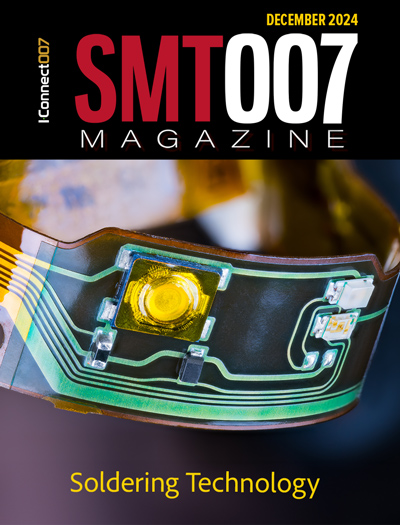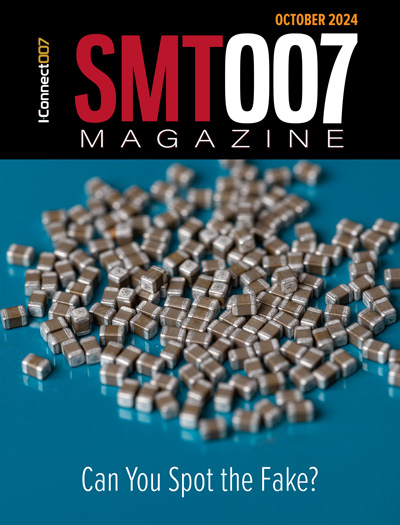-

- News
- Books
Featured Books
- smt007 Magazine
Latest Issues
Current Issue
Soldering Technologies
Soldering is the heartbeat of assembly, and new developments are taking place to match the rest of the innovation in electronics. There are tried-and-true technologies for soldering. But new challenges in packaging, materials, and sustainability may be putting this key step in flux.

The Rise of Data
Analytics is a given in this industry, but the threshold is changing. If you think you're too small to invest in analytics, you may need to reconsider. So how do you do analytics better? What are the new tools, and how do you get started?

Counterfeit Concerns
The distribution of counterfeit parts has become much more sophisticated in the past decade, and there's no reason to believe that trend is going to be stopping any time soon. What might crop up in the near future?
- Articles
- Columns
Search Console
- Links
- Media kit
||| MENU - smt007 Magazine
Hubble’s Advanced Camera for Surveys Instrument Resumes Science, Investigation Continues
November 9, 2021 | NASAEstimated reading time: 2 minutes
NASA is continuing work to resolve an issue that has suspended science operations on the Hubble Space Telescope. The science instruments entered a safe mode configuration on Oct. 25 after detecting a loss of specific data synchronization messages.
The Hubble team is focusing its efforts to isolate the problem on hardware that commands the instruments and is part of the Science Instrument Command and Data Handling Unit. Specifically, the team is analyzing the circuitry of the Control Unit, which generates synchronization messages and passes them onto the instruments.
While analyzing the Control Unit, the team is working to identify potential workarounds for the issue. These include possible changes to instrument flight software that could check for these lost messages and compensate for them without putting the instruments into safe mode. These workarounds would first be verified using ground simulators to ensure they work as planned.
Over the weekend of Oct. 30, the team prepared to turn on parts of the Near Infrared Camera and Multi Object Spectrometer (NICMOS) instrument to collect data on this issue, allowing the team to determine how frequently this problem occurs. Installed in 1997, NICMOS has been inactive since 2010, when the Wide Field Camera 3 became operational. NICMOS allowed the team to use an instrument to collect information on these lost messages while keeping the active instruments off as a safety precaution. Since NICMOS was recovered on Nov. 1, no additional synchronization messages have been lost.
The team is now taking steps to recover Hubble’s Advanced Camera for Surveys (ACS) instrument from safe mode and start collecting science with that instrument at the beginning of next week. The team will make the decision on Sunday after analyzing the latest data. If a lost message is seen before then, the decision to activate ACS will also be revisited. The team is proceeding cautiously to ensure the safety of the instruments and avoid additional stresses on the hardware. Therefore, only ACS will be used in this capacity next week. ACS was selected as the first instrument to recover as it faces the fewest complications should a lost message occur.
Over the next week, the team will continue analyzing the Control Unit design diagrams and data associated with the lost messages to determine what may have caused this problem. They will also be looking into potential instrument software changes that could help address it. Once the team better understands the frequency of the problem and has determined the time needed to implement possible software changes, they will discuss a plan for returning the other instruments to science operations.
Suggested Items
IPC Announces New Training Course: PCB Design for Military & Aerospace Applications
12/23/2024 | IPCIPC announced the launch of a new training course: PCB Design for Military & Aerospace Applications.
Two Additional Boeing O3b mPOWER Satellites Successfully Communicating in Space
12/23/2024 | BoeingTwo more Boeing-built O3b mPOWER satellites are sending and receiving signals in space after launching from the Kennedy Space Center, Florida at 5:26 p.m.
Airbus Awarded Eutelsat Contract to Build OneWeb Low Orbit Constellation Extension
12/19/2024 | AirbusAirbus Defence and Space has been awarded a contract by Eutelsat to build the extension of its OneWeb Low Earth Orbit (LEO) constellation.
Dicro Accepted as a Member of the Defence and Aerospace Industry Association PIA
12/18/2024 | Dicro OyDicro is proud to announce that the company has been accepted as a member of the Defence and Aerospace Industry Association PIA, starting from January 1, 2025. This membership reinforces Dicro's commitment to high-quality and innovative solutions in the defence and aerospace sectors.
Seventh Lockheed Martin-Built GPS III Satellite Launches
12/17/2024 | Lockheed MartinThe seventh Lockheed Martin-designed and -built Global Positioning System (GPS) III space vehicle, GPS III SV07, launched from Cape Canaveral Space Force Station, Florida, into orbit 12,550 miles above earth.


